How to Start Selling with Amazon FBA?
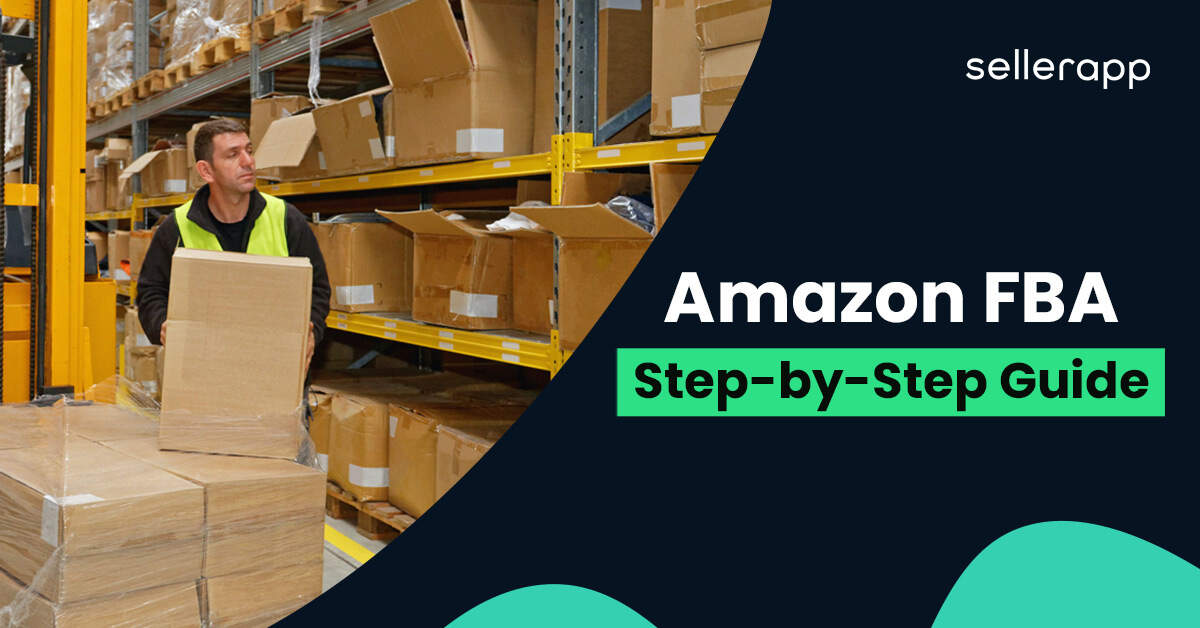
Starting an Amazon FBA business is one of the most effective ways to launch an online venture and generate steady income in 2025. As the ecommerce sector continues its upward trajectory, Amazon remains at the forefront. It captured over 40% of U.S. online retail transactions last year.
With over 180 million Amazon Prime members in the U.S. alone as of 2025, the platform offers sellers unparalleled access to a vast customer base and robust logistical infrastructure (when they opt for Amazon FBA).
The Amazon FBA program simplifies the selling process by offering storage, packaging, shipping, and customer service for sellers, allowing them to focus on growing their Amazon FBA business. By leveraging the Amazon FBA account, you can streamline your operations and tap into Amazon’s extensive fulfillment network.
In fact, 82% of sellers utilized Amazon FBA last year, affirming its popularity and effectiveness. Whether you’re a beginner exploring how to start selling on Amazon FBA or an experienced seller aiming to optimize your operations, understanding Amazon FBA pricing is crucial.
So, in this beginner-friendly guide, you find it all— from Amazon FBA meaning to pricing options, from the pros and cons of Amazon FBA to step by step on how it works, from different business models you can select to a checklist assisting you in deciding whether FBA is for you, and product categories to consider.
Ready to embark on your journey? With the right strategy, awareness, and dedication, you can navigate the ins and outs of what Amazon FBA covers and position yourself for long-term success.
What is Amazon FBA, and how does it work
Fulfillment by Amazon, also known as FBA or Amazon FBA, is a service by the platform dedicated to sellers that enables them to outsource the end-to-end logistics as you sell your products on Amazon’s platform. The fulfillment process includes warehousing, packing, labeling, and shipping your products from their fulfillment centers.
By leveraging Amazon FBA, you reduce your responsibilities and rely on Amazon’s adept services to get your products to your customers on time.
Relieve yourself from the stress of managing the day-to-day operations of your Amazon FBA business. With this all-encompassing logistics suite, you pay Amazon to handle the logistical aspects of your Amazon FBA business while you get to focus on expanding your brand. The following segment will deep dive into how to sell on Amazon FBA.
Step 1: Sellers will send their inventory to Amazon fulfillment centers. Ensure your products are correctly boxed or packed following Amazon’s FBA requirements. In addition to that, an Amazon FBA seller must ensure their product isn’t restricted under Amazon FBA guidelines, which ban certain hazardous or regulated items.
Here are some of the rules you must follow to prevent backlashes from Amazon and subsequent delays:
| Factors | Requirements | |
|---|---|---|
| Box (Carton) packaging | Sturdy boxes | Use corrugated boxes that can withstand shipping. Never reuse boxes. |
| Box size limits | Box length/ breadth can go only up to 25 inches. Approval is required if a longer box is needed. |
|
| Weight limit | Should not exceed 50 lbs (exceptions excluded) | |
| Sealing | Use sturdy packing tape only. | |
| Individual product packaging rules | Each unit must be securely packed. | In case of fragile products, use bubble wrap or protective packaging. Include a suffocation warning label if poly bags over 5 inches are involved. "Fragile - Handle with Care" labels are essential as well. |
| Protective covers for sharp items | This is to prevent any sharp edges poking out, creating a package handling hazard. | |
| Sets must be marked. | If the package involves bundles, demarcation saying “Sold as Set” is compulsory. | |
| Labeling requirements | Each Unit Must Have a Scannable Barcode | Use an FNSKU (Amazon’s barcode) or a manufacturer barcode (UPC/EAN/ISBN). |
| Carton labels | Amazon shipment label (Generated in Seller Central) is compulsory and must be laid on a flat surface. | |
| Pallet labels | If shipping on pallets, each must have four labels, one on each side. |
Step 2: Amazon will receive, sort, and store it in the fulfillment centers.
During this process, the shipment boxes (that you prepared) reach an Amazon Fulfillment Center (FC). These boxes undergo an initial check-in process that approves or discards your packages.
The Amazon FBA authorities make sure the packages comply with the set standards. It may include scanning the boxes, checking shipping labels, and further verification.
Step 3: Amazon will ship products to different warehouses according to demand.
Once Amazon’s fulfillment network receives your shipment, the platform may divide the stock and send portions to different fulfillment centers nationwide. This is called distributed inventory placement, and it helps Amazon reduce delivery times and shipping costs for Prime customers.
You can log into your Seller Central account and monitor your stock. Go to ‘Inventory,’ then click ‘Manage FBA Shipments.’
Amazon decides where each unit goes if you’re using Distributed Inventory Placement. If you prefer to send your inventory to a single location, you can enable Inventory Placement Service (requires added fees).
Step 4: From the Amazon marketplace, the customers will order the seller’s products.
Your inventory levels are automatically updated in real time, minimizing overselling risks. You can monitor performance metrics like order defect rate, late shipment rate, and customer feedback from your Seller Central dashboard to maintain Amazon FBA account health and boost visibility.
Step 5: Once the order is placed, Amazon FBA will pick, pack and ship the product
Amazon FBA itself will take care of the customer service. Which includes returning the product, as well. Once your products reach the warehouse, you can start marketing.
Note: Non-Amazon FBA sellers can opt in for Seller Fulfilled Prime (SFP), but sellers need to qualify to be eligible. This requires a spotless sales history and seller feedback. You’ll also need a professional Amazon seller account to apply for SFP.
Step 6: Now, you can launch and market your products. There are different ways, such as Amazon PPC advertising, social media, and other paid advertisements etc. You can also use marketing strategies like applying discounts or offers to your customers so that they will boost their buying of your products. PPC ads are an excellent way to increase visibility after a new launch.
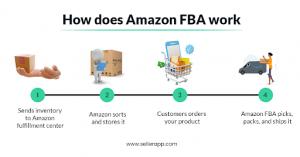
Amazon FBA for beginners: Amazon’s New Seller Incentives (NSI) program
What if we told you that, as a new seller, you could access valuable FBA benefits at no cost through Amazon’s New Seller Incentives (NSI) program, launched in 2024? It offers a comprehensive suite of benefits tailored to help new sellers gain momentum quickly and cost-effectively.
With incentives that span fulfillment, advertising, branding, and early product traction, this set of incentives that new sellers can claim is designed to reduce entry barriers and maximize initial success. Here’s a breakdown of all the FBA Amazon benefits available under the NSI program.
If you’ve ever asked, “How does Amazon FBA work?”—this program offers a powerful, hands-on introduction.
Free FBA Storage
New sellers enrolled in the Amazon FBA program receive free storage for 50 units per new-to-FBA parent ASIN for 90 days after receiving the first inventory at an Amazon fulfillment center. For non-standard-size products, this free storage window extends to 120 days.
It’s a practical look at how Amazon FBA works to simplify logistics for new sellers. This significantly lowers the cost burden for testing new products and helps sellers manage inventory more confidently during the critical launch phase.
Discounted shipping with Amazon Partnered Carrier and AGL
Amazon supports logistics costs by offering $100 in Amazon Partnered Carrier shipping credits, allowing sellers to ship inventory into FBA Amazon warehouses at reduced rates. The program also provides $200 in credits for those importing products for Amazon Global Logistics (AGL), making cross-border inventory planning more affordable.
Requirements?
To qualify for Amazon’s New Seller Incentives, sellers must have a Professional Selling Plan, list their first product after March 1, 2023, and be enrolled in the Amazon Brand Registry (if they own a brand). The NSI program is available in select marketplaces, including the US, UK, Germany, France, Italy, Spain, and Japan. Even existing Amazon sellers can access these benefits when expanding into a new eligible region, making it an ideal launchpad for cross-border expansion.
By leveraging each benefit strategically and learning how to start Amazon FBA, sellers can minimize upfront risks and maximize their product’s potential in a competitive marketplace.
What can you control as an Amazon FBA business owner?
Getting caught up in what FBA Amazon handles for you is easy, but you’re fully in charge in a few key areas. Before knowing how to sell on Amazon FBA, let’s remind you of your responsibilities. So, here are the three essential aspects you’ll manage.
Choosing your products
Amazon gives you access to many products, so the choice is yours! But here’s the catch—pick items that move fast. You don’t want to get stuck with inventory that sits around too long. Focus on what’s trending and has solid demand to better understand how to sell on Amazon FBA successfully.
Managing your inventory
Once your products are in Amazon’s fulfillment centers, it’s up to you to stay vigilant and monitor the stock levels— after all, you run the business. Keep your focus on replenishing your inventory before running out of stock. This is to avoid the dreaded stockout and stay ahead of demand, and keep your store fully stocked.
An Amazon FBA seller should consistently monitor inventory levels in Seller Central and plan restocks 2–4 weeks in advance, depending on lead times, to avoid going out of stock. Understanding how does Amazon FBA work also means mastering inventory flow and forecasting.
Marketing your products
FBA doesn’t handle your marketing, but it helps you run ads with ease. Amazon offers Sponsored Products ads to help you promote your items within the platform and across Amazon’s external channels, such as Fire TV or Twitch. You can use Amazon’s tools to get your products within the sight of potential customers or implement other promotional strategies.
What are the pros and cons of Amazon FBA?
By now, you must have already understood how Amazon handles storage, packing, shipping, and returns using its robust warehousing and shipping capabilities. But apart from that, there is more that you can benefit from. If you’re wondering about “how to start Amazon FBA,” there’s no better way than assessing the pros and cons first. So let’s get started.
Pros of Amazon FBA
Here are some pros that should solidify your plans for learning how to sell on Amazon FBA.
Get multichannel fulfillment
Multi-channel Fulfillment Solutions (MCF) is an extension of FBA Amazon, where you can leverage Amazon’s systematic fulfillment to extend your reach. You can expand your reach to platforms like eBay, Etsy, etc., and leverage Amazon’s extensive shipping network to fulfill orders.
This means you can use Amazon’s expertise to streamline your operations, reduce costs, and offer faster, more reliable shipping to your customers, no matter where they shop.
Prime benefits
An Amazon FBA seller gets access to Prime facilities. Apart from Prime Day access (one of the most significant sales events of the year) and other promotional benefits such as lightning deals and coupons, Prime ensures your customers get fast, free Amazon shipping, reducing buyers’ hesitation.
According to studies, Prime members spend more than non-Prime customers. This leads to the simple conclusion that you can garner higher-order volumes if you get an FBA membership as an Amazon FBA seller.
Boosts the ranking of your product
The Amazon FBA program will help you rank your product in the search results. In addition to that, you qualify for various Amazon badges, which boost your visibility to a great extent. In short, it is a boon for maximizing your discoverability.
Products from Amazon FBA sellers will be classified only by the price, whereas those without FBA products will be classified by the total cost, which is the product’s price and shipping rate. Thus, your products will be ranked.
Say Seller A and Seller B offer a crayon set for $25 and $28, and Seller B is an Amazon FBA seller. As we know, Seller B, an Amazon FBA seller, qualifies for Prime shipping and thus offers free delivery to customers. Even though Seller A offers $3 less than Seller B for zero delivery fee, Amazon ranks Seller B’s product higher in search results because Seller A’s total price, including $5 standard shipping ($25+$5), will be higher by $2.
Trusted customer service
If you use Amazon FBA to run your business, you will get fast and efficient customer service. You don’t have to worry about the complaints and queries of the customers about your product. Instead, Amazon FBA will take care of all these, making your job easier and relieving you from added responsibilities while learning how to start Amazon FBA.
If you’re an Amazon FBA seller, Amazon will be the point of contact for your customers. This means Amazon’s 24/7 customer or even seller support handles returns and customer inquiries. A processing Amazon FBA fee is involved regarding returns, but it’s usually worth it.
Win the Buy Box
The Amazon Buy Box is a crucial feature on the product description page that allows customers to easily add products to their shopping carts and begin the checkout process. Selling the same or similar products will compete for this desired space. Using FBA Amazon, you can increase the chances that buyers will purchase a product from you compared to another seller. You are more likely to win the Buy Box than a self-fulfillment seller. Buy Box mastery is an essential part of starting to sell on Amazon FBA.
Being listed in the Buy Box is a significant benefit in the marketplace. This is because 20 or more sellers will offer the same products, but you will experience more sales when you have the Buy Box advantage.
Scalability and global reach
With Amazon FBA, sellers don’t have to worry about storage limits keeping inventory performance restrictions. Amazon’s limitations on specific product categories or sellers’ performance metrics. What sellers can take away from this? Fewer responsibilities to look for renting warehouses. Managing stock and handling order fulfillment is wholly attributed to FBA Amazon associates. Meanwhile, you can help your Amazon FBA business scale faster without logistical constraints.
Say you start your Amazon FBA business with 100 units of handmade scrunchies. The demand for your product spikes for some viral trends, so you quickly escalate the inventory, holding up to 10,000 units. With the FBA services, Amazon can expand warehouse space. So when the demand shoots up even more with time, you can have an ample supply of the item.
However, Amazon may impose storage limits based on your Inventory Performance Index (IPI), especially during high-demand periods like Q4.
Amazon FBA allows sellers to use Amazon’s international fulfillment centers, making it easier to reach customers in multiple countries. FBA Export will enable sellers to fulfill international orders without the hassle of separate fulfillment operations.
Amazon Global Selling (AGS) and Pan-European FBA programs help sellers expand into markets like the UK, EU, Canada, and Australia without any requirement to set up warehouses in foreign countries.
When a U.S.-based Amazon FBA seller lists an item through FBA Global Export, Amazon handles the entire cross-border shipping and customs process.
Cons of Amazon FBA
Here are some of the cons you need to watch out for before acting on your plan to learn how to become an FBA seller on Amazon.
Fee for Amazon FBA
The Amazon FBA charges specific fees. The main costs include packing, monthly storage, long-term and order fulfillment, and Amazon FBA fees. All these mean you must pay based on how much inventory you store, for how long, etc. While the FBA Amazon fee follows a structured format, it varies based on product size, category, and seasonality.
These can significantly affect your margins if not correctly calculated. So, that means you will have to understand your sales volume with the right amount of inventory to maintain a profit. Also, you must ensure that the Amazon FBA fee you’re paying is cost-effective for your Amazon FBA business, or you can end up at a loss.
Inventory tracking
If your products become out of stock, Amazon will reduce its ranking and visibility, which will lead to lower sales. So, a steady flow of inventory is essential. As supply chains become more digitized, prioritizing manufacturing cybersecurity is crucial to protect inventory data and prevent disruptions from cyber threats.
Prepare the requirements for your products.
Before your products are sent to fulfillment centers, Amazon has some requirements. Amazon’s ASIN/ UPC system, where you have to pack and label your products individually. So, you have to ensure all these are done before shipping it to Amazon. If not, it can be challenging.
Increased returns
Indeed, the easy returns policy availed by Amazon FBA leads to higher volume sales, but easy return policies associated with Prime may also lead to higher return rates. In many cases, Amazon refunds the customer before inspecting the returned item, while sellers bear the brunt.
Returns of high-ticket items may be a recurring problem for sellers. Amazon FBA sellers can add a restocking fee (a percentage of the item’s price deducted from the refund when the customer returns a product) for returns to prevent impulse purchases.
High Amazon FBA fees may impact profit margins.
Amazon FBA charges monthly and long-term storage fees depending upon the space you occupy for storing your inventory. Storing bulky or oversized items can cost you an even higher Amazon FBA fee. In addition, if inventory products are slow-moving items, storage costs will keep increasing, cutting into profitability. Thus, collectively, the FBA Amazon fee is mainly on the higher side, almost always impacting profit percentage.
An Amazon FBA seller must pay a removal or disposal fee to eliminate unwanted inventory. In case of returns, they may have to pay for the returned stock to be shipped back.
Say you, as a seller, have 100 unsold units of a seasonal item you must dispose of. Amazon FBA charges $1.50 per unit for removal, costing you $150, which adds to a loss.
Dependency on Amazon policies
Way back in 2023, Amazon raised storage Amazon FBA fee by up to 10%. The most affected sellers were the ones with extensive inventories. As a result, many had to increase product prices to cope with the loss or find alternative fulfillment options.
This real-life occurrence made Amazon FBA sellers second-guess their decisions. Although they were uncomfortable with the unforeseen policy change, they could not switch to FBM (Fulfilled by Merchants) as they wouldn’t be allowed to switch back to Amazon FBA status once sellers gave it up.
Here’s everything summed up:
| Pros | Cons |
|---|---|
| Simple to create with minimal resources | Susceptible to cognitive biases (e.g., framing effect) |
| Encourages thorough consideration of outcomes | May overlook emotional and intuitive factors |
| Helps reduce emotional bias by promoting objectivity | Not ideal for complex decisions with multiple alternatives |
| Provides clear visual comparison of factors | Can lead to over-reliance on analytical data |
| Flexible for individual or collaborative use | Subjective weighting of pros and cons |
| Useful for quick preliminary critical thinking | May miss nuanced or qualitative aspects |
Amazon FBA business models: Which one should you choose?
Amazon offers multiple ways for an Amazon FBA seller to make money, each with advantages and challenges. Whether you’re looking for a hands-off passive income stream or want to build a full-scale ecommerce brand, there’s a model for you to create an Amazon FBA business based on your goals.
Here’s a breakdown:
| Amazon FBA Business Model | Best For | Profit Potential | Pros | Cons |
|---|---|---|---|---|
| Private Label | Brand builders selling unique/custom products | High | Higher margins, brand ownership, and scalability | High upfront costs and inventory risks require marketing |
| Wholesale | Selling established brands with lower risk | Moderate to high | Lower risk, no product development, quick scaling | Capital-intensive, brand restrictions, price competition |
| Retail Arbitrage | Beginners with minimal investment | Low to moderate | Low startup costs, quick to start, part-time friendly | Time-consuming sourcing, brand restrictions, hard to scale |
| Online Arbitrage | Sellers who prefer online deal sourcing | Low to moderate | Remote-friendly, no physical stores, lower costs | Price volatility, retailer restrictions, and high competition |
| Dropshipping | Sellers are avoiding inventory management | Low to moderate | No upfront inventory, easy product testing | Strict Amazon policies, thin margins, unreliable fulfillment |
| Amazon Handmade | Artisans/craft sellers | Moderate to high | Niche market, loyal customers, less competition | Approval delays, time-intensive production, and higher fees |
Amazon FBA for beginners: The prerequisites
One needs to fill in a few requirements before they learn how to start Amazon FBA.
Choose a niche and the product.
Amazon FBA for beginners starts with choosing the right niche and product—this is the foundation of your success. Before creating your Amazon FBA account, you must divert to first choose a niche i.e, the category of product you will sell on the Amazon marketplace. When you start researching categories, you may feel overwhelmed, but the best way is to pick one niche and continue with it.
While researching a product, try to look for which product has the best selling rank,and check for its features. We suggest you look into the reviews and understand the customer pain points, too. If you find products sold between $10 – $50, it is a good opportunity because customers usually buy products between these price points. To make your research easier you can use SellerApp’s product research, which shows the product’s ratings, price, and category.
Although it’s dependent upon the category, profitability calculation is a major area that needs attention. So, use the Profit Calculator from the SellerApp Chrome extension for the best estimates. Success with Amazon FBA depends on how well you calculate your profits and keep a fair profit margin
Look for products with steady demand but not overly saturated with sellers. A mid-level Best Sellers Rank (BSR) can indicate potential without overwhelming competition. Use the opportunity score finder of the SellerApp Chrome extension to better understand the scopes of success with a particular product.
Read more on how to use the SellerApp Chrome Extension: HERE
For seasoned sellers who are looking to expand their catalog, we recommend you use SellerApp’s Amazon FBA API to thoroughly understand the profitability of products.
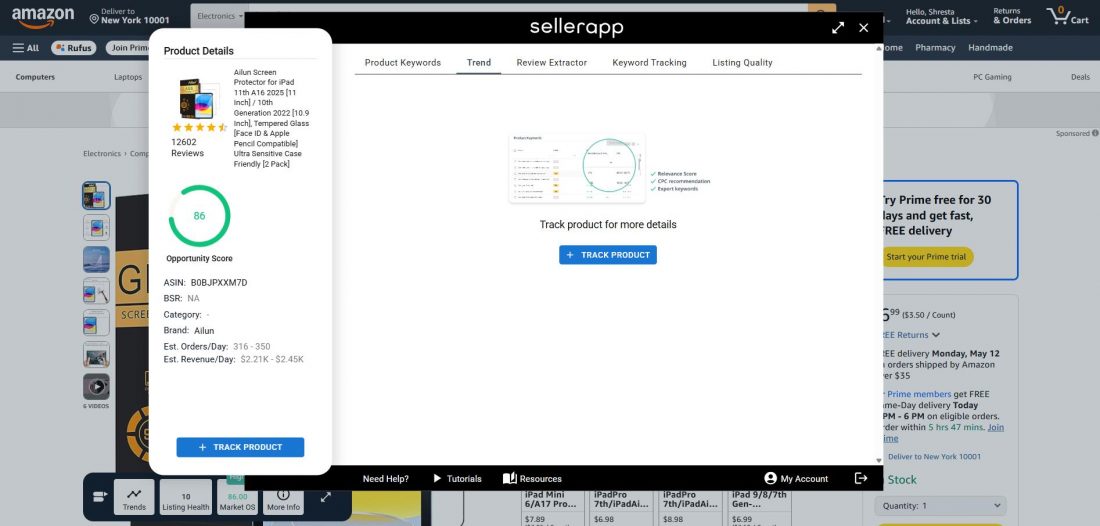
How to source products on Amazon FBA
If you’re exploring Amazon FBA for beginners, this stage is especially critical—solid product research can make or break your business.
The journey to sourcing the right products for Amazon FBA business begins with a deep dive into what’s popular. The goal is to find something with high sales volume and low competition, so you can make a solid profit, well, an ideal case scenario. Apart from that, you can take note of trends and competitor ratings to understand what people seek.
Finding reliable suppliers
Once you’ve got your eye on some products, the next step is to find a reliable wholesaler or supplier. Find all the information about the product, like the supplier’s details, product details, etc. Now, this is where it gets exciting—you’ve plenty of options to choose from! Platforms like Alibaba are sellers’ favourite for finding manufacturers, especially for private-label products, as the platform lets you ask for samples from these wholesalers or even establish a 1:1 communication. This makes product customization easier than ever.
Negotiating Amazon FBA pricing and terms
Now that you’ve found a supplier you like, it’s time to get down to business. Amazon FBA pricing and terms can be clarified by referring to the toolkit we provide under the Sellerapp Chrome extension. But once you have negotiated wholesale prices and it’s settled, this is where you can find a major difference in your profit margins.
For those pursuing Amazon FBA for beginners, starting with suppliers who offer low MOQs (Minimum Order Quantities) can be a smart move to minimize initial risk. And don’t forget to clarify payment terms (like a deposit or full payment upfront). It’s different for every wholesaler. When working with a supplier, you’ll need to agree on payment terms before you stabilize the system. We suggest you always clarify these terms in advance to avoid miscommunication and protect your investment.
To elaborate, either you’re paying a deposit upfront (like 40%) and the rest after production, or making a full payment upfront. Deposit is safer and more flexible, especially recommended for beginners, as it reduces upfront risk.
Depending on your strategy, you’ll also need to decide whether you want to go with private labeling, where you brand your products as your own, or wholesale, where you buy products to resell. If you’re following a guide on Amazon FBA for beginners, build flexibility into your initial agreements—you’re still testing the waters.
Preparing your products for Amazon FBA
Okay, you’ve got your products from your supplier, now it’s time to prepare them for the rest of the process. Amazon has strict packaging, labeling, and barcoding requirements. Failing to meet them can result in a penalty and disruption in business.
Also, ensure each product is labeled and prepped with an Amazon FNSKU barcode unless you’re using Amazon’s Labeling Service.
From labeling to shipping, mastering this part of the process is a must for anyone navigating Amazon FBA for beginners—even small mistakes can create costly delays.
Steps to create an Amazon FBA account
There’s no separate Amazon FBA account. When you sign up for an Amazon Seller account, you can choose FBA Amazon as your fulfillment method during or after listing your product. Let’s see how.
Sign up for an Amazon FBA
You need to sign up for Amazon FBA before you start your Amazon FBA business.
- First, visit Amazon.com
- Click ‘Sell on Amazon‘
- Select which account you need: ‘Sell as an Individual’ or ‘Sell as a Professional.’ There is a difference between these two plans.
Create your product listing.
You need to create a product listing to add your product to Amazon.
- Visit your Amazon Seller Central account and click ‘Menu.’
- Choose ‘Catalog’ and click on Add product’.
- Now, create a new product listing and select the product category you will sell.
- Fill in the product listing details such as titles, descriptions, bullet points, images, videos, etc. Here, you’ll be given the fulfillment option.

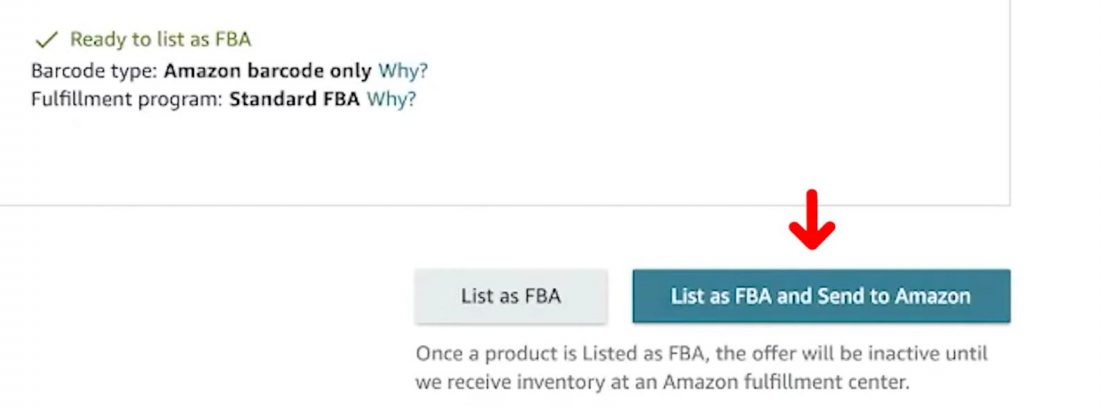
- After this, you can click on the ‘List as FBA and Send to Amazon’ to start as quickly as possible. (assuming you have your products ready in hand).
You can optimize your product listing on Amazon because it can help you get more sales and increase your product ranking. Check out this detailed step on creating a new listing. It is ideal for Amazon FBA for beginners.
Amazon FBA fees
Amazon FBA charges include:
- Amazon FBA storage fees – For storing inventory in Amazon’s warehouses.
- Amazon FBA fulfillment fees – For picking, packing, and shipping orders.
- Amazon FBA variable fee – Miscellaneous charges per order processed.
- Amazon FBA referral fees – Percentage of each item’s sales price.
Shipping and handling-related Amazon FBA charges
There is no need to worry about counting nickels and dimes for picking, packing, and shipping items for your Amazon FBA business. Amazon collates these added Amazon FBA charges into a single fulfillment fee.
The two Amazon FBA pricing structures:
Low-price FBA fees: For products priced under $10
Regular FBA fees: For products priced at $10 or more
Note: Amazon calculates and imposes fulfillment fees based on product size tiers and shipping weight. Amazon considers whichever is higher between unit weight and dimensional weight.
Items that qualify for Ship in Product Packaging (SIPP) can get a discount of $0.04 to $1.32 per unit. It is an FBA Amazon program allowing eligible products to be shipped in the manufacturer’s packaging. As it requires no extra Amazon-branded box, you get the discount.
Storage-related Amazon FBA fees
Amazon has updated its Storage Utilization Surcharge (SUS) fees by the start of 2025, particularly impacting sellers with high storage-to-sales ratios. According to the revised rules, seasonality will play a significant role. For standard-size products, the standard storage fee will decrease by $0.09 per cubic foot during the non-peak period (i.e., from January to September), reducing the fee from $0.87 to $0.78 per cubic foot.
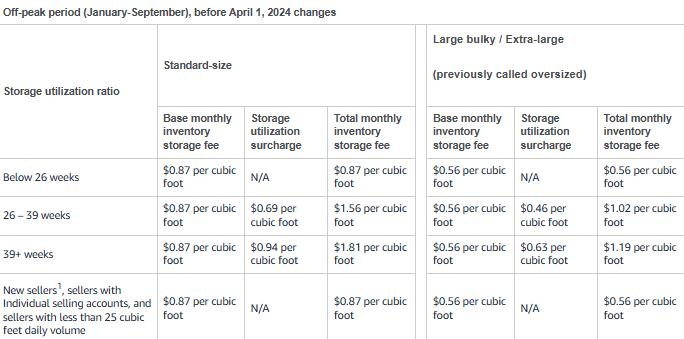
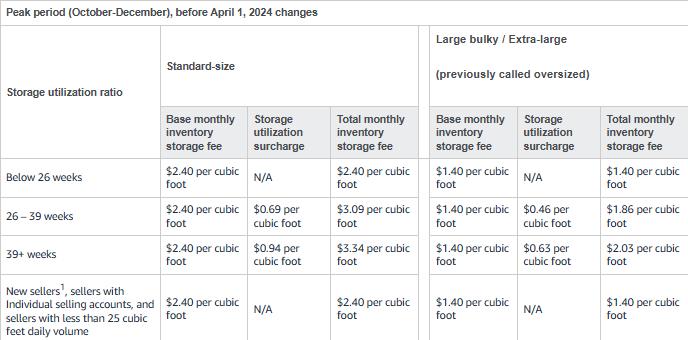
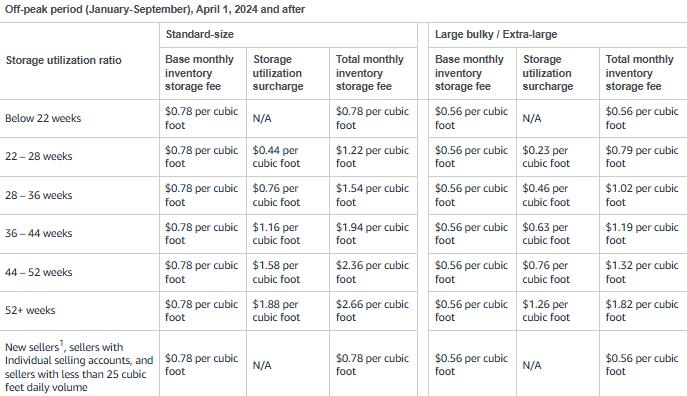
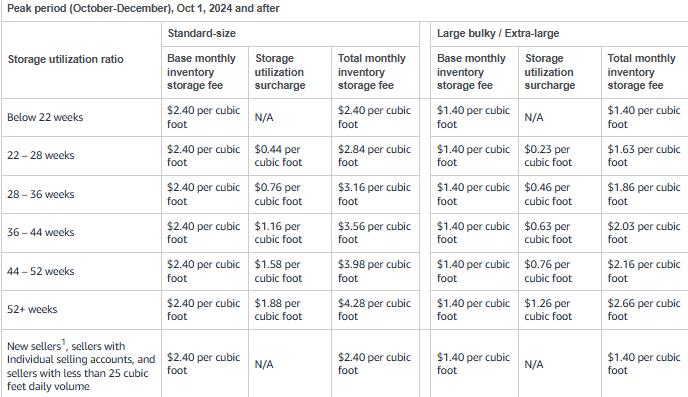
Items stored for over 365 Days are subject to a long-term storage fee of $6.90 per cubic foot or $0.15 per unit (whichever is greater will be considered). Amazon has its ways of rewarding sellers and maintaining sufficient inventory levels. Amazon offers a 10% discount on AWD storage fees for sellers, promoting better inventory planning.

Inbound placement service fees
Inbound placement service fees are the cost of distributing your product inventory across Amazon’s fulfillment network. Amazon will eliminate inbound placement service fees for new parent ASINs enrolled in the FBA New Selection program. It is levied upon the first 100 units per ASIN.
The high fulfillment costs associated with adding new SKUs may have sellers with limited budgets on the fence about extending their business. Doing that would require distributing their inventory across various fulfillment centers, costing them a high upfront budget.
This is even more challenging for ambitious sellers with a vision of expanding their product offerings. Say you’re selling t-shirts on Amazon. Offering a variety of colors and sizes will require a higher upfront cost.
According to the revised rules of 2025, inbound placement service fees will be reduced by an average of $0.58 per unit for shipments.
Amazon FBA Referral Fees
You can consider referral fees as a “commission” paid to Amazon for each item you sell via the Amazon marketplace. It usually varies between 8% to 15%. At the end of the month, the fee is calculated and deducted from your bank account linked to your Amazon account. For apparel items priced under $15, they will decrease referral fees from 17% to 5%. For products priced between $15 and $20, they will decrease referral fees from 17% to 10%.
Amazon is lowering costs on lower-priced apparel items. This could be a token of encouragement for apparel sellers trying to break into the Amazon marketplace with their fast fashion items. With the rise in consumers’ tendencies to dabble with new fleeting trends, Amazon understood the scope of fast fashion and thus revised its rules to attract more apparel sellers in this category.
Other Amazon FBA charges
- For each return your brand incurs above that category’s threshold, you will be charged a per-unit fee between $1.78 and $157.35+, depending on the product’s size tier and shipping weight.
- If you choose to have Amazon remove and return your inventory to you or dispose of it for you, they’ll charge $1.04-$14.32+ per unit, depending on the shipment’s weight.
- An unplanned FBA prep fee between $0.20 and $2.00 is charged to an Amazon FBA seller who has not prepared products according to stringent packaging and prep guidelines.
- Amazon may charge merchants an Amazon FBA fee if a product’s inventory level relative to its short- and long-term historical demand is below 28 days. Fees range from $0.89 to $1.11 per unit, depending on the item’s sizing tier, shipping weight, and historical days of supply.
- The 2025 changes aim to reduce operational burdens and costs for Amazon FBA sellers.
Commingling: Another factor to consider
Counterfeit and mislabeled products are a massive problem in online marketing. Many counterfeit products slip and reach customers, without physical verification of the products. This can cost an honest seller if they sell the same product and enable commingling.
So, what is commingling?
Commingling is a fulfillment option available for FBA sellers where Amazon puts together products from different sellers for processing and shipment. These products will have the same manufacturing ID from different merchants or brands selling on Amazon. The products are then used to fulfill customers’ orders. This means that when an order for Seller A’s unit of inventory arrives, it can be fulfilled by any identical product Amazon has on hand, from any seller. If your competitor or a dishonest seller is sending a counterfeit version of your product, then it can harm your reputation. This can bring a black mark to your product and can lead to many unhappy customers.
If you have enabled commingling, then it can make it easier for sellers to send products to the Amazon warehouse. If you are not commingling your product, then you will have to individually label each product that you send to Amazon.
The commingling inventory option allows sellers to save time and labor costs. It doesn’t require individual labels but instead uses a barcode to group products together.
Here’s how you can change your commingling settings:
- Navigate to ‘Settings’ on your Seller Central account
- Select ‘Fulfillment by Amazon’
- Scroll down the page and look for ‘FBA product barcode preference’
- Edit ‘Amazon barcode’ to remove commingling
So if you don’t want to commingle your products, then you can decide to label the products yourself. You can also allow Amazon to do it for you, but they will charge you for their service.
Calculating Amazon FBA Fees
Let’s take the example of selling wireless earbuds as a part of the Amazon FBA program.
- Selling Price: $50
- Size Tier: Small standard-size item (10 oz)
- Fulfillment Fee: $3.22
- Referral Fee: 15% of the selling price ($50 × 15% = $7.50)
- Storage Fee (per month): $0.83 (based on volume)
Total Fees:
Fulfillment Fee: $3.22
Referral Fee: $7.50
Storage Fee: $0.83
Total Amazon FBA Fees = $11.55 per unit
When is Amazon FBA right for you?
Here’s how to judge if Amazon FBA makes the most sense for your product offerings:
Your products are lightweight, compact, and fast-moving
Categories such as electronics accessories, beauty products, and small gadgets are among the ones that get sold the fastest. That said, Amazon FBA fees are well-optimized for items under 3 lbs. A faster-moving inventory can lower your risk of paying long-term storage fees, preventing unforeseen losses.
You aim to win the Buy Box.
Amazon prioritizes Amazon FBA sellers’ listings over others to gain priority in the Buy Box race. Although it may seem unfair, Amazon trusts its fulfillment network as it can predict its operation. If FBA gives you Prime eligibility, it can move the scales in your favor.
You can deliver fast.
In this fast-paced world, customers look for speed as much as they seek quality. Amazon Prime members dominate the marketplace; they expect fast, top-quality, and free shipping, which Prime provides. Amazon FBA fulfills orders in two days (or even same-day), increasing your conversion rates significantly.
Regarding impulse buys, seasonal products, and trending items, timing makes a ton of difference. Amazon FBA sellers get an opportunity to strike the iron while it’s hot.
You want to outsource the customer care responsibilities to Amazon
Scaling a business can be hard to handle when you’re solely responsible for customer inquiries and processing return requests. With Amazon FBA, you can make Amazon’s expert team execute all of it while you focus on expanding your business. Fair deal, right?
It is especially suited for solopreneurs or emerging businesses with small teams that want to focus on growth instead of fulfilling logistical duties.
You want to escape the warehousing & logistics hassles
Managing a warehouse is expensive, time-consuming, and unnecessary, with limited manpower. Amazon FBA allows you to expand your product lines without investing in storage, packing, or shipping infrastructure.
If you practice multichannel marketplaces, centralized fulfillment is a perfect solution.
Most Amazon FBA account holders are also set up at other marketplaces such as eBay, Walmart, or independent websites. Amazon’s multi-channel fulfillment (MCF) enables a centralized logistics network to ship orders from multiple platforms.
Your margins can absorb FBA fees.
Amazon FBA may make it look easy, but it isn’t easy to afford. However, maintaining substantial profits while paying for FBA Amazon services will not be a prominent issue if your product has healthy margins.
If you sell a product at $55 and its price is $15, you can still afford Amazon FBA services while keeping a significant profit margin.
If you check off multiple boxes above, opting for the Amazon FBA program is a good idea. But if your margins are razor-thin or your products are oversized, you should consider alternate options to the Amazon FBA program, such as FBM.
What to Sell with Amazon FBA?
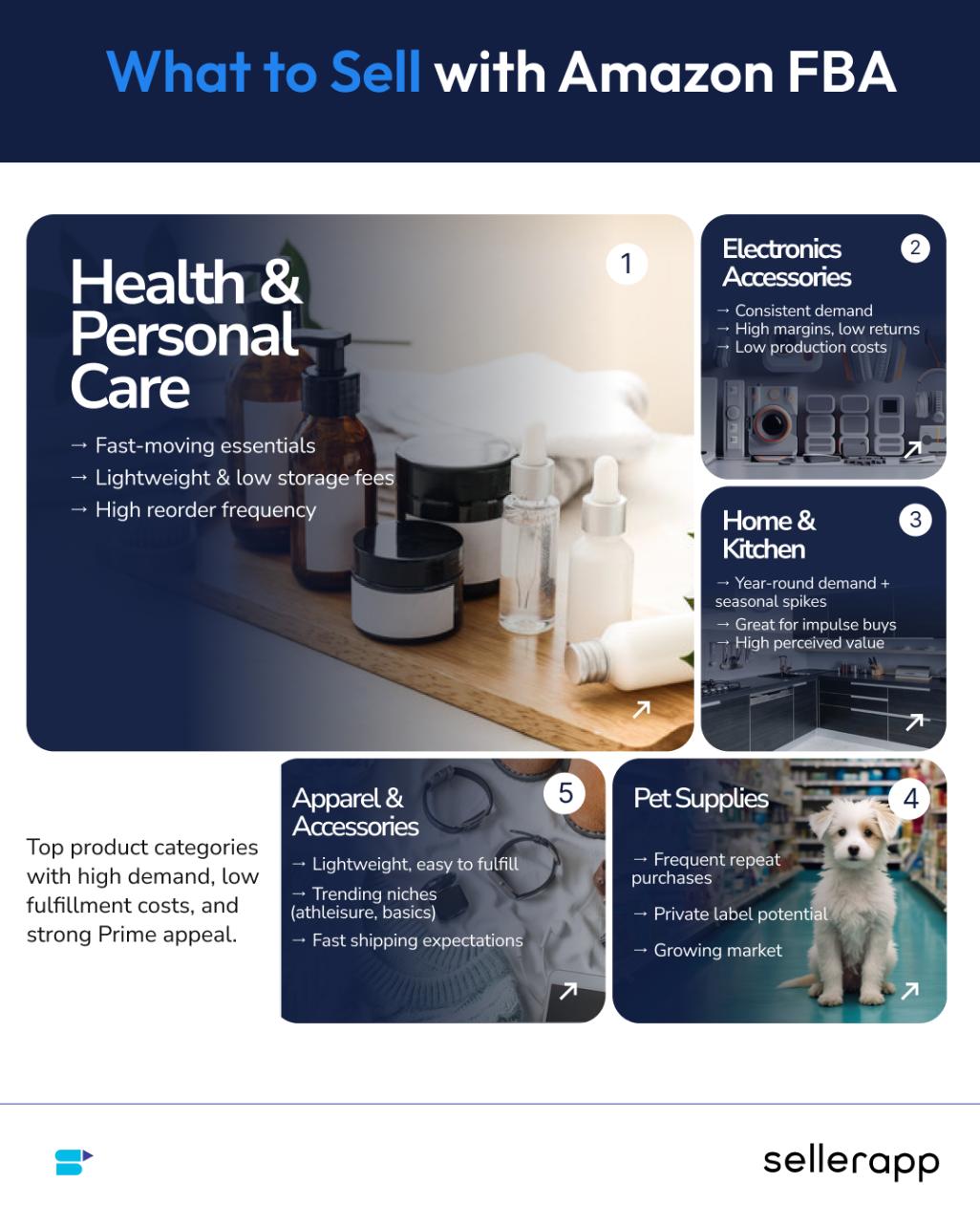
When choosing the right product category for the Amazon FBA program, you must consider fees, demand, competition, and ease of fulfillment. If you’re wondering how to start Amazon FBA, refer to these options to get a head start. Some categories work exceptionally well with FBA because of their high turnover, Prime demand, and low fulfillment costs. Here’s a list.
1. Health & personal care
In this category, we have options such as collagen supplements, eye creams, soaps or shampoos, etc, that witness high repeat purchases. Customers need to restock regularly and are known as fast-moving goods or FMGC. This translates to consistent sales volume and thus requires lower storage fees. This makes it an excellent fit for Amazon FBA. Additionally, these items are mostly lightweight, reducing fulfillment costs, which makes them an excellent fit for the Amazon FBA program.
Amazon Prime eligibility is crucial in this category as these are daily essentials. For example, a seller offering a particular organic shampoo will essentially be preferred by customers for FBA’s one-day delivery.
2. Electronics accessories
With new laptops launching every year and smartphones launching new updated versions with desirable features, the demand for accessories remains unwavering. Products like wireless chargers, Bluetooth headphones, and adapters offer high margins due to low manufacturing costs and consistent demand.
Unlike leading electronics, accessories surprisingly have a lower return rate. Selling these electronic accessories will reduce the risk of high Amazon FBA fees for return processing. The best part is that, in many cases, the products come with a no-return policy and a limited-time warranty.
3. Home and kitchen
It’s a plain fact that home and kitchen products maintain a steady demand in the rear-round. It occasionally experiences a seasonal spike during the holidays, especially during spring cleaning when people discard worn-off items or during back-to-school season when students seek new items for their dorms. Items like yoga mats, organizers, and LED lights are popular Amazon FBA picks. Amazon FBA sellers often advertise these products based on practicality, social media virality, and impulse-buy appeal.
Many home products have a relatively high perceived value despite having low manufacturing costs, leading to healthy profit margins for sellers. For example, a set of LazySusan dupe can be sourced for $5 but sold for $20 on Amazon.
4. Pet supplies
The U.S. pet industry is reaching its all-time high, with owners spending billions of dollars on furry friends. Amazon FBA sellers, because of their high repeat purchase rate, are expanding their businesses. The order frequency is high for treats, supplements, and grooming products. We often overlook how pet supplies are ideal for private labeling and branding under the Amazon FBA program.
5. Apparel and accessories
Although a highly competitive category, specific apparel niches—such as athleisure, minimalist fashion, and sustainable fabrics—are emerging as evergreen fashion. Customers are getting used to certain styles to match their everyday comfort, so they expect fast shipping for their frequent needs. This category contains lightweight, primarily clothing items like socks, caps, and belts, which are essentials and easy to store and ship, maintaining a low fulfillment cost as part of the Amazon FBA program.
Final thoughts
Amazon FBA offers a world of opportunities for sellers, but like any great business model, it requires careful planning and strategy. From storing your products to shipping the inventory directly to customers, the Amazon FBA program simplifies many operational challenges of running a low-effort online business.
By understanding how to sell on Amazon FBA for beginners and leveraging the right tools, such as Reverse ASIN to track your market competitors’ strategies or you can opt for our Amazon PPC services to unlock the full potential of Amazon FBA and watch your business grow. Ready to take the plunge? Amazon has room for all!



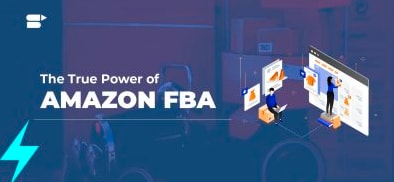

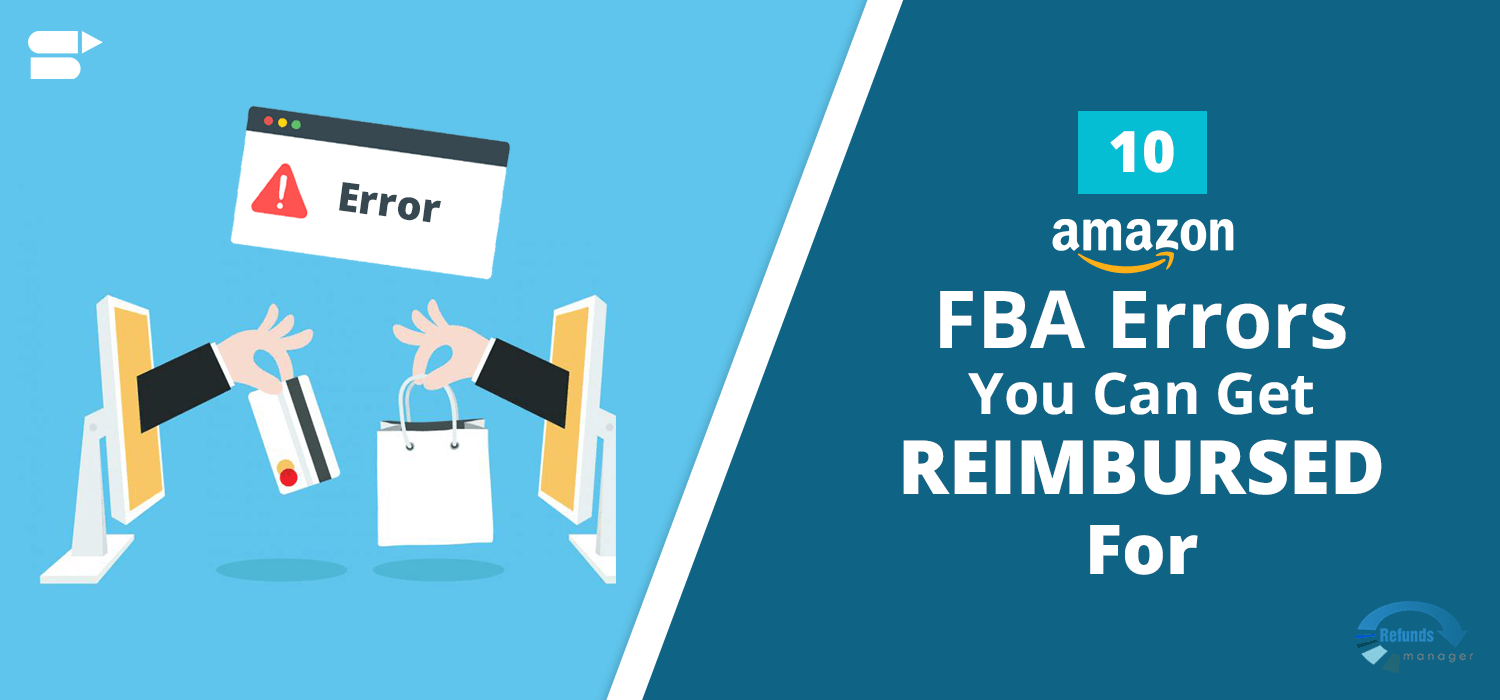
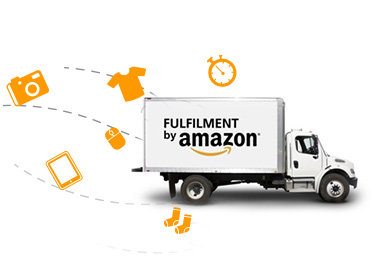
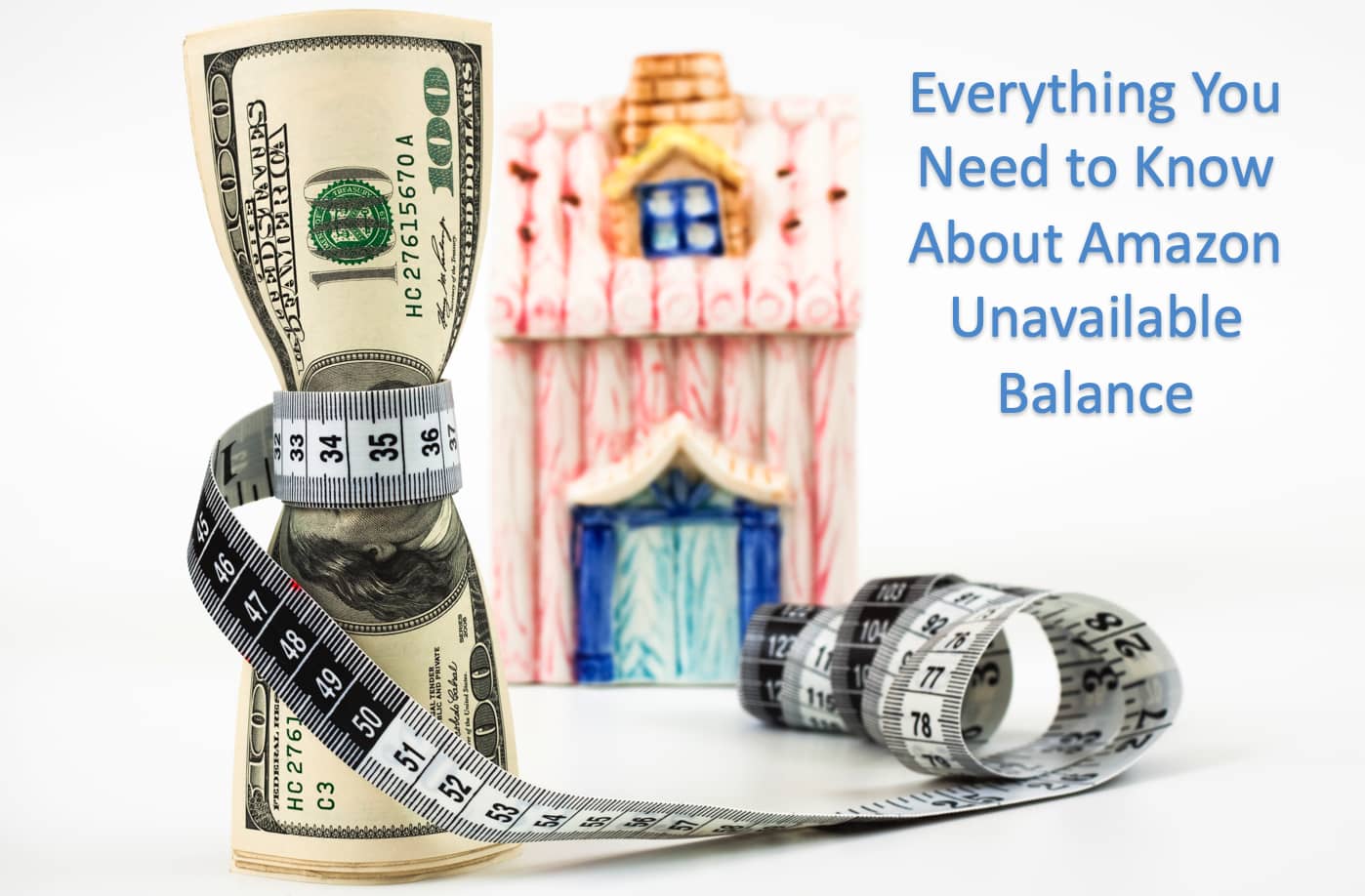
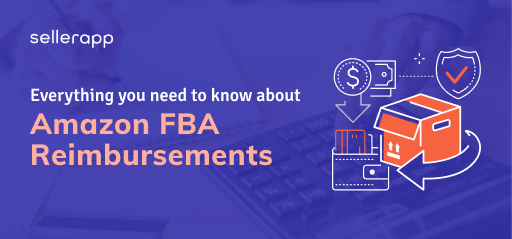
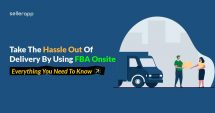
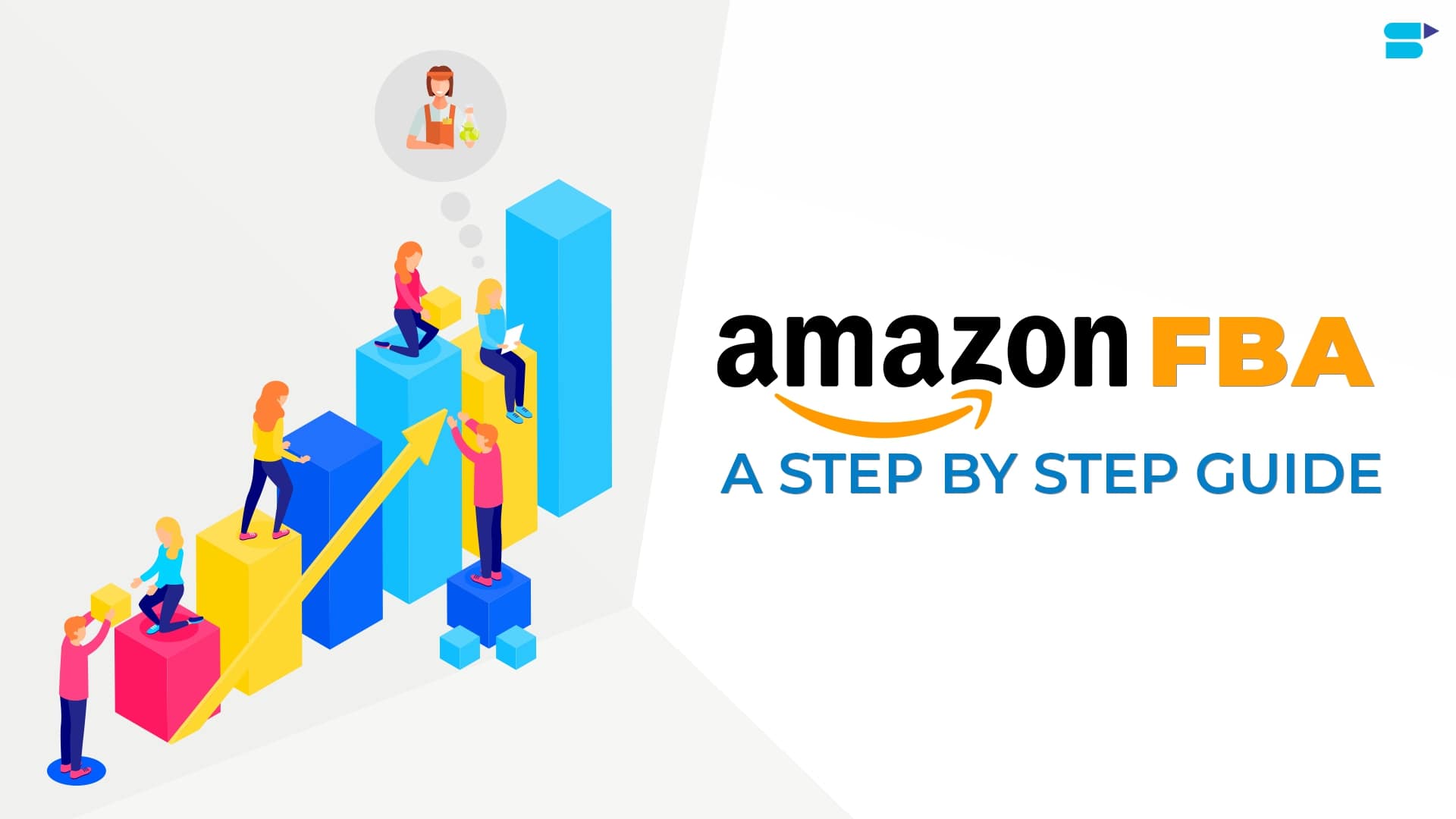
Kim
December 10, 2020How does the Amazon FBA calculator help in selling on amazon?
Arishekar N
June 15, 2021Amazon FBA calculator helps you in determining the product profits, sales, and seller fees.
For detailed information please check out this resource:
https://www.sellerapp.com/blog/amazon-fba-fees-calculator-guide/
Mina
February 25, 2021An excellent Amazon FBA guide. Thank you SellerApp for sharing this valuable content.
Arishekar N
June 15, 2021Glad you liked the article.
Leonardhat
May 28, 2021Very Helpful Blog. This was the information I was looking for.
You guys are wonderful
Thank you SellerApp
Arishekar N
June 22, 2021Thank you for your feedback.
EsvinZooNy
May 28, 2021Does Amazon Increase the Storage Fees during Holiday Season?
Arishekar N
June 22, 2021Storage fees are hiked during the holiday season (October to December). To learn more about Amazon FBA fees, We recommend you to review the following article: https://www.sellerapp.com/blog/amazon-fba-fees-calculator-guide/
AmyWab
May 29, 2021That’s an excellent blog for a beginner like me. Well written and lots of detail. Thank you.
Arishekar N
June 22, 2021Thank you.
Shahid masih
June 11, 2021Very clearly explained about Fulfillment by Amazon (FBA)
Videos are very Informative.
Thank you SellerApp.
Arishekar N
June 22, 2021Very happy to hear that.
Thank you.
Arishekar N
June 22, 2021Thank you for your feedback.
Houston
January 12, 2023I would definitely recommend SellerApp to any Amazon seller looking to take their business to the next level.
Arishekar N
January 16, 2023Thank you.
Madison
January 12, 2023SellerApp’s Amazon FBA blog is a game changer for anyone looking to sell on Amazon.
Arishekar N
January 16, 2023Thank you.